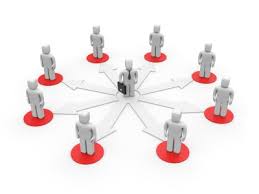Merchants are perhaps the most famous image of an intermediary, the not-so-loved “middleman” that buys cheap, sells dear, and becomes rich doing little work.  Even in the supposedly dark Middle Ages, merchants could openly operate creating Merchant Guilds that promoted regional trade while protecting members from potential abuses by powerful landlords and countervailing the staunch opposition of the Catholic Church. Merchants and traders were also part of the Greek and Roman empires.
Even in the supposedly dark Middle Ages, merchants could openly operate creating Merchant Guilds that promoted regional trade while protecting members from potential abuses by powerful landlords and countervailing the staunch opposition of the Catholic Church. Merchants and traders were also part of the Greek and Roman empires.
Nevertheless, not every single intermediary is necessarily a merchant. In economics, an intermediary is an agent or enterprise between a product (or service) and the consumer. A supply chain for a given product might indeed have multiple intermediaries that handle the merchandise in one way or another. As final consumers, we are not usually fully aware of the detailed structure of such supply chains. We just go to a store and get the product – or use a digital device to order online.
At least three types of intermediaries exist. First, the entity between me and the product has access to information I lack. The middle agent is thus a knowledge broker and profits from it. This scenario is related to the theory of information asymmetries, and countless examples are readily available. Second, the agent can access a logistics network that moves and delivers the product or service. Merchants also rely on such agents to transport products to the final destination. Supply chains can have multiple logistics intermediaries working in tandem with conventional middle agents. In general, competing and replacing such intermediaries is relatively tricky. Finally, intermediate agents can also create value for the consumer. The classic example here is banks that take my money and, in return, pay me a given interest. This works as long as deflation is not in action; otherwise, I must pay for bank services provided, a so-called negative interest rate. Banks then lend pooled capital to investors who pay higher interest rates on such loans. This is how traditional banks used to make profits.
The concept of disintermediation, which emerged in the late 1970s, is associated with the latter type of intermediation. Financial disintermediation occurs when consumers take matters into their own hands and run and manage financial transactions, thus bypassing traditional banks. The concept is also associated with the birth of investment banking, which, in a way, created a new series of powerful intermediaries. Not that banks have disappeared from the financial scene. On the contrary, many of them are also engaged in investment banking. The 2007/08 Global Financial Crisis clearly showed this evolution.
One of the many promises of the mid-1990s Internet was the elimination of all intermediaries, the disintermediation paradise. This included even governments which were, according to this view, doomed and soon to disappear inexorably. Tacking stock twenty-five years later, we beg to disagree. So what happened then?
For starters, a new set of Internet intermediaries emerged, just like in the case of financial disintermediation. This is well documented in an OCED report on the subject, which is a bit dated but still conveys the message. Bear in mind that the Internet creates a new digital economy that generates new products and services but, at the same time, competes with the old analog one by disrupting core business processes. Only the more resilient survive. New intermediaries in both realms can and have surfaced while others have vanished.
Second, a new type of middle agent has emerged. Intermediaries are no longer just agents or enterprises. We now have also what I call network intermediaries in the digital world. Nowadays, I should be able to access a digital network to get information or buy a product or service. I usually have to pay for such access and often must provide personal data and information. Unlike traditional ones, network intermediaries do not need to own assets, products, or information to be effective. Instead, they make a living from the sheer volume of network users and the data gathered. This is what makes these new digital intermediaries unique.
Unlike the other types, network intermediaries operate globally. They can easily reach billions in almost real-time – even though nearly half of the world’s population is still not connected to the Internet. Some have labeled this process as disintermediation, but that does not seem to square with the conceptual definition of such a process. Instead, we have the global centralization of intermediation and disintermediation. There are very few intermediaries here (GAFA is one acronym used to describe them), and competing with them seems very difficult. In this context, this set of new digital intermediaries reminds us of those older ones described above who operate at the logistics level.
But there is more. Within such networks, a whole new set of intermediaries have seen the light of day due to the tsunami of information and data generated by the Internet. While I can still go directly to a specific vendor or site, I would instead use an intermediary that aggregates data and facilitates my interactions when I have too many possible choices. Think about traveling, shopping, watching online films, and even fake news outlets. These intermediaries function similarly to the traditional knowledge broker ones.
In the end, we can conclude that while some disintermediation has occurred, most probably on the analog side of the economy, intermediation has increased simultaneously, especially in the digital realm. While more research is needed here, one point is clear: the Internet does not inherently promote disintermediation.
Can new technologies such as blockchains change this pattern? Maybe, but the jury is still out. I am not that optimistic, however.
Cheers, Raúl


Comments
One response to “The Global Centralization of (Dis)Intermediation”